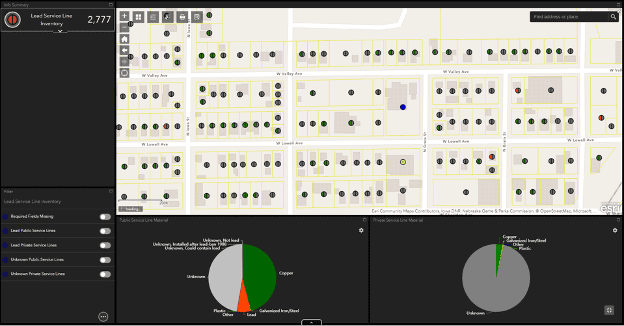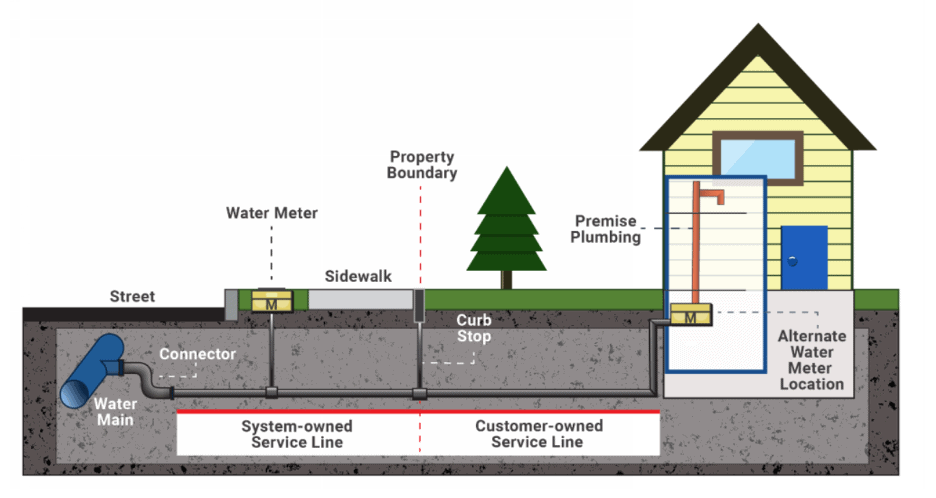While one of the crowning achievements of the 20th century was building reliable water systems, after a century, our water infrastructure is at risk. The problems that face our drinking water systems are multi-faceted. Lead service line inventory continues to be an evolving issue due to a combination of aging infrastructure and improving standards for drinking water.
The Lead and Copper Rule (LCR) historically focused on reducing lead and copper levels in Public Water Systems by establishing a monitoring and sample plan to track customers’ water quality, strengthen treatment methods when needed, and provide improvements to public notification and education.
However, the U.S. Environmental Protection Agency (EPA) has refocused the LCR regulations to better identify the source of lead in public water systems, strengthen treatment for drinking water by establishing a lower trigger level for lead, and instituting find-and-fix and other public notification requirements. EPA’s goal is to ensure community water systems have plans to reduce lead in drinking water.
Changes to EPA Lead and Copper Rule and Upcoming Deadlines
As an update on the current progress and direction of the updated Lead and Copper Rule, the following is a summary of regulatory developments over the last few years:
- November 2019: Following the Flint crisis, EPA worked to develop a new regulatory framework and proposed a rule revision to the LCR.
- December 2020: A Final Lead and Copper Rule Revision (LCRR) was signed and enacted. The LCRR included new provisions for developing a lead service line inventory (LSLI), find-and-fix mechanisms, greater public reporting requirements, and instituting new thresholds in lead levels for customers that strengthen treatment requirements.
- January 2021: The enforcement of the LCRR was subsequently delayed to gather additional public feedback.
- December 2021: The EPA announced next steps:
- Water utilities are to proceed with developing LSLI’s as initially included as part of the 2020 LCRR. These inventories are required to be completed by October 16, 2024. More on these inventories below.
- The remaining portions of the LCRR will be revisited for opportunities to improve the final regulation. Additional guidance and rulemaking for a new Lead and Copper Rule Improvement (LCRI) will be made by the EPA prior to the October 16, 2024 deadline of the initial LCRR.
Identifying Lead Service Line Inventory
The EPA has provided a template inventory document, and individual states are providing additional local guidance and inventory criteria. To streamline the data acquisition and meta-data (such as photos), a geographical information system (GIS) database can store all the information which the LCRR and LSLI require and serve to meet the EPA’s requirement of a publicly available inventory for larger communities.
HR Green is already working with clients on developing a customized GIS database to store information for their lead service lines (image below). This dashboard and mobile form application allow Utility staff to easily collect data and photos themselves utilizing a smartphone or tablet directly syncing with the GIS database. This provides a cost-effective way for Utilities to meet the new lead and copper regulations while collecting data when time is available without purchasing any specialized equipment. HR Green then manages the database and makes it available to all customers on a publicly-available website. In addition, the always up-to-date GIS Dashboard allows the utility to track progress and provide the local regulators with real-time updates.

Lead Water Lines in the U.S.
It is estimated that there are between 6 to 10 million lead service lines in the United States. Most of these lead service lines are 2-inch diameter and smaller, and primarily serve single-family residential and small multi-family residences. The most common sources of lead in drinking water are lead pipes and brass or bronze faucets and fixtures. However, finding where lead pipes are still used can be challenging, especially since service lines are commonly owned (at least partially) by the customer and not the water utility. The first step in implementing the new rule requires water systems to develop an LSLI of its distribution system service lines. An example of a water service line and potential ownership extents is shown below.

(Source: EPA’s Guidance for Developing and Maintaining a Service Line Inventory)
Maintaining Lead Service Line Inventory
Some common questions quickly arose, such as ‘what level of verification is needed?’; ‘is a desktop study sufficient, or is field excavation required?’; ‘and what to do about the customer’s private portion of the service line?’ EPA released Guidance for Developing and Maintaining a Service Line Inventory in August 2022 to provide additional information on how data should be collected for developing LSLIs, what data is required, and how to maintain the inventory moving forward. State regulators may expand or implement more stringent regulations concerning these inventories; it’s recommended that each public water system contact their local regulators for additional guidance.
The inventories developed as part of the LSLI requirement should identify each service line connected to the distribution system and identify them as one of the following:
- Lead – Note that lead connectors, or “goosenecks” are not considered lead service lines (LSLs).
- Galvanized Requiring Replacement (GRR) – This includes galvanized service lines that were ever downstream of an LSL.
- Non-Lead – This could include galvanized service lines confirmed never to be downstream of an LSL, copper, or plastic service lines.
- Unknown Status – Any unknown service lines will count towards the total number of lead (or potential lead) service lines that could require replacement under the upcoming LCRI regulations. For this reason, EPA recommends against classifying service lines as Unknown Status whenever possible.
The inventories are required to track service line materials for both the utility and customer-owned portions of the service lines and supporting data for how the inventory was developed. Verification methods for establishing service line materials can include the following historical information and records:
- Utilizing historical information such as the initial LCR tiered sample sites as part of the initial 1991 LCR
- Desktop review of construction and plumbing codes used over time and comparing the age of the service lines to these standard codes
- Water system records, such as tap or punch cards
- Meter installation records
- Distribution system maps
A field investigation of the service line is not required under the LCRR, but public water systems can conduct one as an optional way to investigate unknown service line materials further. Investigation methods include visual inspection, scratch tests, magnet tests, water quality sampling, excavation, predictive modeling, and other emerging methods. For reference, examples of typical service line materials are shown below.

(Source: EPA’s Guidance for Developing and Maintaining a Service Line Inventory)
Our Water Engineering Services
HR Green provides comprehensive water services to move public and private projects from conceptual planning through design, financing, permitting, construction, start-up, and operation. Our engineers make accountable decisions in the planning and design of potable water systems.
HR Green Water Services:
- Funding Assistance
- Pilot + Treatment Studies
- Master Planning
- Wells + Well Fields
- Storage + Reservoirs
- Treatment Plants
- Pumping Systems
- Distribution Systems
- Construction Phase Services
If you need assistance with complying with the upcoming LCRR regulations or in the development of an LSLI, please contact one of the regional contacts below:
Colorado
Greg Panza, PE | gpanza@hrgreen.com | 719-394-2436
Iowa
Josh Scanlon, PE | jscanlon@hrgreen.com | 720-602-4939
Illinois
Kyla Jacobsen | kjacobsen@hrgreen.com
Ravi Jayaraman, PE, ENV SP | rjayaraman@hrgreen.com | 815 759-8312
Minnesota
Mark Hardie, PE | mhardie@hrgreen.com | 605-221-2647
Missouri
Josiah Holst, PE, CFM | jholst@hrgreen.com | 636-541-6636
South Dakota
Sam Cotter, PE | scotter@hrgreen.com | 605-221-2659
Texas
Leigh Thomas, PE | leigh.thomas@hrgreen.com | 737-304-6896
GIS Inventories
Mike Liska | mliska@hrgreen.com | 319-841-4360



